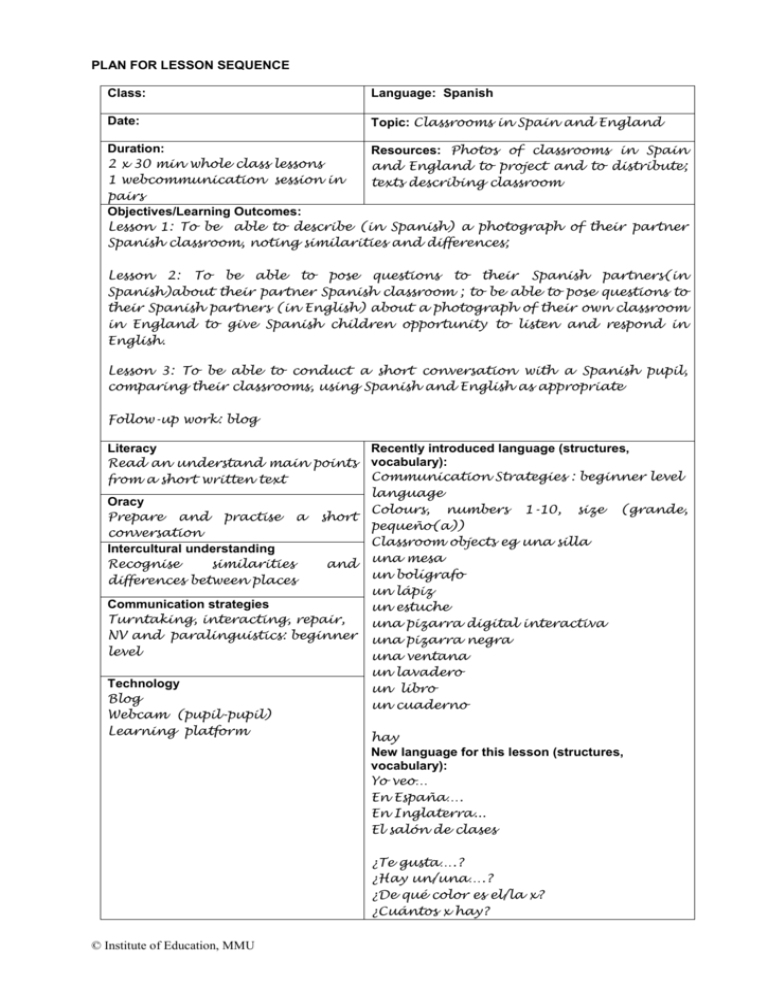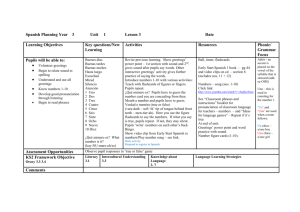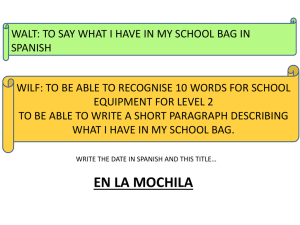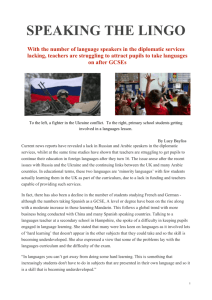LP lesson classroom comparisons
advertisement

PLAN FOR LESSON SEQUENCE Class: Language: Spanish Date: Topic: Classrooms in Spain and England Duration: Resources: Photos of classrooms in Spain 2 x 30 min whole class lessons and England to project and to distribute; 1 webcommunication session in texts describing classroom pairs Objectives/Learning Outcomes: Lesson 1: To be able to describe (in Spanish) a photograph of their partner Spanish classroom, noting similarities and differences; Lesson 2: To be able to pose questions to their Spanish partners(in Spanish)about their partner Spanish classroom ; to be able to pose questions to their Spanish partners (in English) about a photograph of their own classroom in England to give Spanish children opportunity to listen and respond in English. Lesson 3: To be able to conduct a short conversation with a Spanish pupil, comparing their classrooms, using Spanish and English as appropriate Follow-up work: blog Literacy Read an understand main points from a short written text Oracy Prepare and practise a conversation Intercultural understanding Recognise similarities differences between places short and Communication strategies Turntaking, interacting, repair, NV and paralinguistics: beginner level Technology Blog Webcam (pupil-pupil) Learning platform Recently introduced language (structures, vocabulary): Communication Strategies : beginner level language Colours, numbers 1-10, size (grande, pequeño(a)) Classroom objects eg una silla una mesa un bolígrafo un lápiz un estuche una pizarra digital interactiva una pizarra negra una ventana un lavadero un libro un cuaderno hay New language for this lesson (structures, vocabulary): Yo veo… En España…. En Inglaterra... El salón de clases ¿Te gusta….? ¿Hay un/una….? ¿De qué color es el/la x? ¿Cuántos x hay? © Institute of Education, MMU ¿Qué más? Lesson 1 Starter Teacher greets class in Spanish as appropriate and class respond; Teacher on LP flashes photograph of Spanish classroom up briefly; ¿Qué es? (un salón de clases); ¿Dónde es, en España o en Inglaterra? Main Display photo of Spanish classroom on IWB. In pairs, pupils brainstorm Spanish words that they know and compile a list to feed back (5 mins) ; teacher provides correct spelling during feedback, eg una silla una mesa un bolígrafo un lápiz un estuche una pizarra digital interactiva una pizarra negra una ventana un lavadero un libro un cuaderno Opportunities For Assessment Teacher monitors already known vocabulary, pronunciation, and overall pupil participation Teacher monitors understanding of text Pupils in pairs compose sentences beginning with ‘en España hay….’ and ‘en el salón de clases veo….’, ‘yo veo…’ Teacher takes oral feedback. Teacher gives out short written text identifying 3 things in the Spanish classroom (photo with text underneath, available on LP). Pupils spot the 3 things in the text and circle on photograph. Teacher displays photo on IWB and reads text; pupils come up and circle relevant part of photo. Plenary Teacher says sentences based on photo (yo veo un/una x, hay un/una x) – pupils repeat if true. Teachers close session as appropriate (adios, gracias, buen provecho, hasta pronto, etc) © Institute of Education, MMU Monitor understanding of spoken TL Lesson 2 Starter Teacher greets class in Spanish as appropriate and class respond; Recap of previous lesson – how much about the photo can they remember without seeing it (in Spanish)? OR: teach plays true/ false game eg ‘las paredes son azules – ¿sí o no?’ Main Display photo on IWB; teacher displays questions and models 4 examples of questions, one of each type; class in groups are given one question starter per group from the following so that all are covered: ¿Te gusta el/la...? ¿Hay un/una….? ¿De qué color es la/el x? ¿Cuántos (as) x hay? Monitor understanding of spoken TL Monitor number of different questions produced based on example How many questions can you make? Group of pupils ask the rest of the class their questions ; pupils answer where possible, incorporating ‘no se’ where appropriate and any relevant communication strategies phrases eg ‘no entiendo’ ‘puedes repetir por favor’… Teacher displays photograph of classroom in England; in English, pupils in groups decide upon question s to pose to Spanish partners on blog. Teacher takes suggestions and class © Institute of Education, MMU Monitor pronunciation and use of communication strategies Monitor /guide agree on set of questions to post on blog – do as whole group. Plenary pupils to posing questions at appropriate linguistic level Teacher asks questions based on English picture to elicit comparisons. Lesson 3 Independent pupil-pupil communication session (2 countries) Prior to communication session, pupils in pairs to draw picture of their own classroom or an ideal classroom or fantasy-based classroom, based upon a picture template that they add detail and colour to (eg draw/ colour desks, chairs, bags). Communication session: Pupils to initiate communication and respond as appropriate (using taught communication strategies); Pupils in TL to ask partner in other country about drawing of classroom, using questions practised as set out above: ¿Te gusta el/la...? ¿Hay….? ¿De qué color es la/el x? ¿Cuántos (as) x hay? ¿Qué más? Pupils to listen to answers, indicating whether they are following or not and requesting repetition where needed; pupils draw a picture based on the information understood on a blank template. Hold picture up to camera to compare. Pupils swop over and describe their picture in © Institute of Education, MMU Pupil self-assessment after session, using checklist L1in response to questions; comparison as above. Pupils close conversation eg by thanking and say good-bye. Follow-up work Blogging Class work in groups: on alternate weeks, each class checks blog and in groups seek to understand responses in TL and pose further questions and comments in L1. © Institute of Education, MMU Evaluation of lesson sequence: © Institute of Education, MMU






